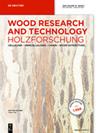Effect of pressurized hot water extraction on the resistance of Scots pine sapwood against mould fungi
IF 2.2
3区 农林科学
Q2 FORESTRY
引用次数: 0
Abstract
Abstract The effects of pressurized hot water extraction (HWE) treatment on the mould resistance of wood have not been extensively investigated yet. The activity of the mould fungi is dependent on the availability of nutrients. Therefore, the soluble degradation products produced during HWE treatment could affect the wood’s susceptibility to mould growth. Scots pine (Pinus sylvestris L.) sapwood specimens were treated with HWE at 140 °C for 1–5 h. Afterwards, the degradation products were either removed via leaching or the wood was dried without applying the leaching procedure. The surface layer (1.5 mm) was removed from half of the leached and non-leached specimens. The resistance of the specimens against mould growth was tested in an incubation chamber. HWE treated wood showed a higher susceptibility to mould growth when it was neither leached nor subjected to surface removal. The susceptibility of wood to mould fungi depended on the availability of hemicellulose-based degradation products produced during HWE treatment. These degradation products were removable via a leaching procedure, but also by removing the outermost layer of the wood. The results show the relevance of removing HWE degradation products located on the wood surface in improving resistance against mould growth.加压热水浸提对松材对霉菌抗性的影响
加压热水浸提(HWE)处理对木材抗霉性的影响尚未得到广泛的研究。霉菌的活性取决于养分的可用性。因此,HWE处理过程中产生的可溶性降解产物会影响木材对霉菌生长的敏感性。将苏格兰松(Pinus sylvestris L.)边材样品在140°C下用HWE处理1-5小时。然后,通过浸出去除降解产物或在不使用浸出程序的情况下干燥木材。从浸出和未浸出的一半样品中去除表层(1.5 mm)。在孵育室中测试了样品对霉菌生长的抗性。HWE处理过的木材在既不浸出也不进行表面去除的情况下,对霉菌生长的敏感性更高。木材对霉菌的敏感性取决于HWE处理过程中产生的半纤维素基降解产物的有效性。这些降解产物可以通过浸出过程去除,也可以通过去除木材的最外层来去除。结果表明,去除位于木材表面的HWE降解产物与提高木材抗霉菌生长的相关性。
本文章由计算机程序翻译,如有差异,请以英文原文为准。
求助全文
约1分钟内获得全文
求助全文
来源期刊

Holzforschung
工程技术-材料科学:纸与木材
CiteScore
4.60
自引率
4.20%
发文量
83
审稿时长
3.3 months
期刊介绍:
Holzforschung is an international scholarly journal that publishes cutting-edge research on the biology, chemistry, physics and technology of wood and wood components. High quality papers about biotechnology and tree genetics are also welcome. Rated year after year as one of the top scientific journals in the category of Pulp and Paper (ISI Journal Citation Index), Holzforschung represents innovative, high quality basic and applied research. The German title reflects the journal''s origins in a long scientific tradition, but all articles are published in English to stimulate and promote cooperation between experts all over the world. Ahead-of-print publishing ensures fastest possible knowledge transfer.
 求助内容:
求助内容: 应助结果提醒方式:
应助结果提醒方式:


